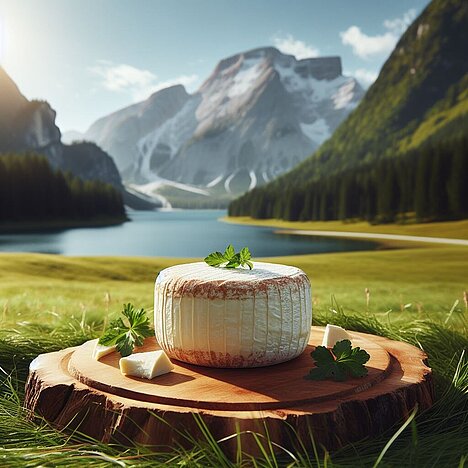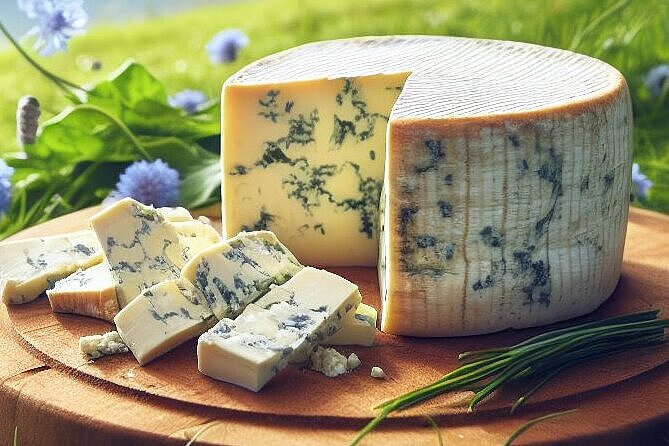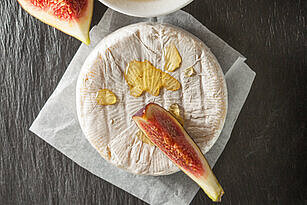Cambozola

Cambozola is a delicious soft cheese made from cow's milk that combines the characteristics of Camembert and Gorgonzola. It comes from the Allgäu region in Germany and has been produced by the Champignon cheese dairy since the 1970s. But is Cambozola also suitable for dogs? In this article, you will find out everything you need to know about Cambozola as an ingredient for your four-legged friend.
What is Cambozola?
Cambozola is a soft cheese with blue mold that has a creamy and rich consistency. It has a mild and slightly sweet taste, reminiscent of butter and cream. It has a white rind, which is edible, and a light yellow color with blue veins. Cambozola is made from pasteurized cow's milk to which lactic acid bacteria and noble mould cultures are added. The cheese matures for around four weeks in special maturing chambers where the temperature and humidity are controlled.
What are the benefits of Cambozola for dogs?
Cambozola can have some health benefits for dogs if fed in moderation. For one thing, it contains a lot of calcium, which is important for strong bones and teeth. Secondly, it also provides protein, which is necessary for muscle building and cell regeneration. It also contains vitamins such as A, B2, B12 and D, which can support the immune system, eyesight, nerve function and skin health. Finally, the blue mold in cambozola may also have probiotic properties that can improve intestinal flora and aid digestion.
What are the disadvantages of Cambozola for dogs?
Cambozola can also have some disadvantages for dogs if it is fed too often or too much. For one thing, it is very high in fat and calories, which can lead to obesity and cardiovascular problems. Secondly, it also contains a lot of lactose, which can lead to flatulence, diarrhea or vomiting in some dogs. In addition, the blue mold in Cambozola can also trigger allergic reactions or symptoms of poisoning if it is spoiled or moldy. Finally, the high salt content in Cambozola can also increase blood pressure and put a strain on the kidneys.
How much Cambozola can a dog eat?
The amount of Cambozola a dog is allowed to eat depends on various factors, such as the dog's weight, age, state of health and activity level. In general, however, Cambozola should only be given as an occasional reward or supplement to normal food. A rule of thumb is that no more than 10% of a dog's daily calorie requirement should come from cheese. This means, for example, that a 10 kg dog should not eat more than 20 g of Cambozola per day.
How do you feed Cambozola to a dog?
If you want to feed your dog Cambozola, you should follow a few tips to avoid possible risks. Firstly, you should always make sure that the Cambozola is fresh and not expired or moldy. Secondly, you should cut the Cambozola into small pieces or crumble it and mix it with the normal food or give it as a treat. Thirdly, you should always observe your dog's reaction and look out for signs of intolerance or allergy. Fourthly, you should always provide fresh water so that your dog can quench his thirst.
Cambozola is a delicious soft cheese that can have some benefits for dogs, such as calcium, protein, vitamins and probiotics. However, it should only be fed in moderation as it can also have some disadvantages, such as fat, calories, lactose, salt and blue mold. If you want to feed your dog Cambozola, you should always pay attention to the quality, quantity, preparation and your dog's reaction. This way you can offer your four-legged friend a healthy and enjoyable change.
If you notice any signs of hypersensitivity or poisoning in your dog, you should see your vet immediately. We are not a substitute for a vet, but we try to be as accurate as possible. Every dog reacts differently and we recommend you get a second opinion or consult your vet if in doubt.
Stay healthy and take good care of your four-legged friend!😊
Similar to Cambozola
Gorgonzola is a soft cheese with at least 48% fat in dry matter that is produced in the Italian regions of Piedmont and Lombardy. It has a protected designation of origin and may only be produced in...
Brie is a soft cheese from the blue cheese family. It is made from pasteurized or raw cow's milk and mixed with lactic acid bacteria and mould. The mold rind forms during the ripening process and...
Roquefort is a cheese named after the village of Roquefort-sur-Soulzon in the south of France. It has a protected designation of origin, which means that it can only be produced in this region under...
Stilton is a cheese that takes its name from the village of Stilton in Cambridgeshire, where it was first sold in the 18th century. However, it can only be produced in the counties of Derbyshire,...



